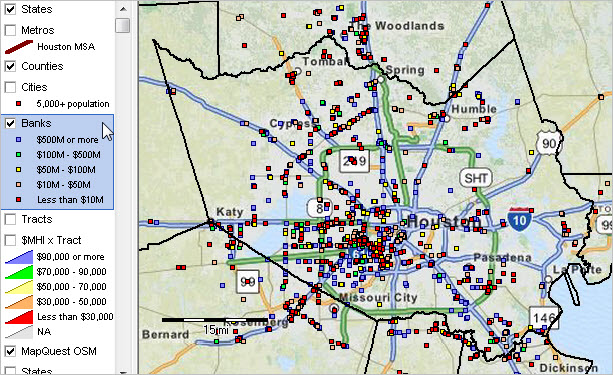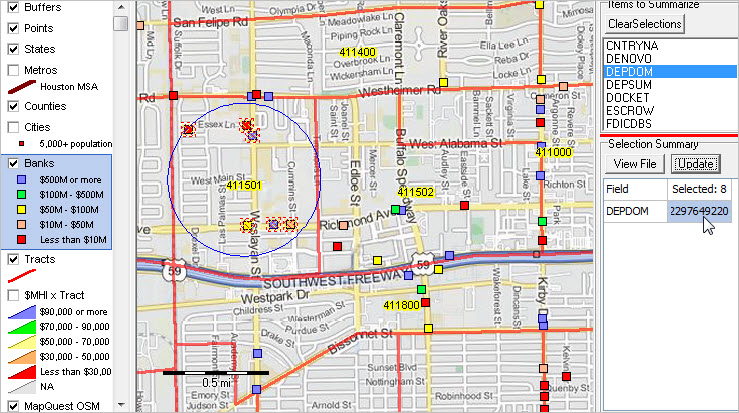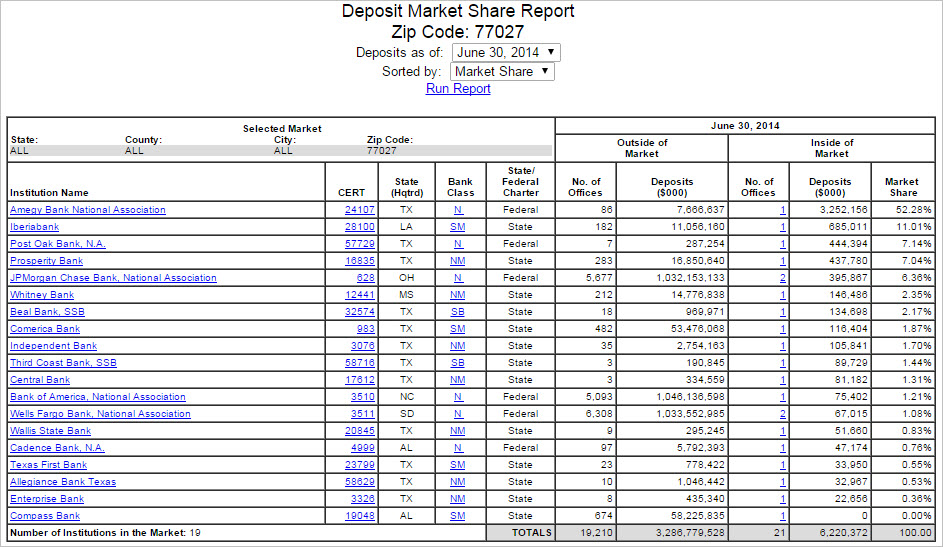

|
|
Financial Institutions & Neighborhood Characteristics -- examining patterns & geographic relationships
This section illustrates use of FDIC Deposit Market Share (DMS) data by institution. Subsequent sections will integrate other related data into the GIS applications including the FFIEC "Census 2014/2015" dataset (data by state, metro, county and census tract). Deposit Market Share The Deposit Market Share (DMS) is the percentage of deposits an FDIC-insured institution has within a defined geographic market. We use these data in GIS applications reviewed below. See the example of the DMS Report below in this section. These data are based on the annual Summary of Deposits survey of FDIC-insured institutions. The DMS data provide information for each/all FDIC-insured institutions by address and a range of related attributes. Market presence and growth rate analyses can be examined annually by institution or bank holding company. The 2014 annual DMS address-based data were geocoded and converted into a shapefile for GIS analysis. The DMS shapefile was integrated into a GIS project. The GIS project also includes a U.S. national scope census tracts shapefile with demographic-economic data from the 2013 American Community Survey 5-year estimates (ACS2013). GIS tools can be used to examine a single institution, institutions within a geographic area or aggregated within a geographic area. Optionally examine these institutional locations in context with patterns of neighborhood or regional economic prosperity (or choose many other types of subject matter). Branch Locations by Size; Houston, Texas The map presented below shows banks as markers in the Houston, TX area. Harris County appears with bold blank boundary. Bank markers shown by 2014 deposit size class. See size class/color patterns in legend at left of map.  Click graphic for larger view; view developed with CV XE GIS. Map view developed using FIM2015 GIS Project. Branch Locations in Context of Neighborhood Economic Prosperity Similar to the map above, the map below shows banks as markers in the Houston, TX area. Patterns of economic prosperity (based on median household income - MHI) are shown by census tract/neighborhood. See MHI intervals/color patterns in legend at left of map. It is easy to see where concentrations of banks in more affluent neighborhoods.  Click graphic for larger view; view developed with CV XE GIS. Selecting Specific Institutions -- using site analysis tool The map presented below shows financial institution locations as markers with a zoom-in to neighborhood level. The site analysis tool is used to select a set of institution locations within a census tract (red boundary, yellow label) -- tract code 4115.01 or 411501, located in Harris County, TX. See more about census tracts. Eight locations are selected (hatched markers) using the circle selection method (any location intersecting with circle is selected). Alternatively select only one institution, visually cherry-pick certain institutions or apply a select-from-list query. One variable is summarized, sum of deposits 2014 ($2.2 billion for sum of these 8 locations).  Click graphic for larger view; view developed with CV XE GIS. Tabular View of Selected Institutions The view presented below shows the data grid populated with attributes of the eight selected locations (see above). This view is displayed by using the View File button -- see at right of map view in above graphic. The table/grid shows the institution/branch name, sum of deposits for that location, and other attributes. Optionally save this selection of locations an a dbase/CSV/Excel/text file for further analysis.  Click graphic for larger view; view developed with CV XE GIS. Deposit Market Share Report The view presented below shows the Deposit Market Share Report for ZIP code 77027. This report is for the ZIP code area that includes the selected locations shown above. See the full interactive DMS report.  Click graphic for larger view. Top 50 Commercial Banks & Savings Institutions; Total Domestic Deposits Interactive Table See related Ranking Tables Main Page Usage: click column header to sort; click again to sort other direction. Notes Deposits of all FDIC-Insured Institutions as of June 30, 2014; NA: National Association Financial Institutions GIS Project The Financial Institutions GIS project can be used to examine national scope to small area financial institutions by location in context of market characteristics. Gain insights not possible using tabular data alone. Use the Financial Institutions GIS Project to create your own maps similar to those shown above. 1. Install the ProximityOne CV XE GIS (only required if not already installed) ... run the CV XE GIS installer ... take all defaults during installation 2. Download the Financial Institutions GIS Project fileset ... requires ProximityOne CV XE GIS Level 2/3 ID ... unzip Financial Institutions GIS project files to local folder c:\fim2015 3. Open the c:\fim2015\fim2015.gis project ... after completing the above steps, click File>Open>Dialog ... open the file named c:\fim2015\fim2015.gis 4. Done. Start-up view appears. Related Resources • Mapping Neighborhood Patterns -- State-by-State GIS Projects; Low & Moderate Income Support Using these Resources Learn more about demographic economic data and related analytical tools. Join us in a Decision-Making Information Web session. There is no fee for these Web sessions. Each informal session is focused on a specific topic. The open structure also provides for Q&A and discussion of application issues of interest to participants. ProximityOne User Group Join the ProximityOne User Group to keep up-to-date with new developments relating to geographic-demographic-economic decision-making information resources. Receive updates and access to tools and resources available only to members. Use this form to join the User Group. There is no fee. Additional Information ProximityOne develops geographic-demographic-economic data and analytical tools and helps organizations knit together and use diverse data in a decision-making and analytical framework. We develop custom demographic/economic estimates and projections, develop geographic and geocoded address files, and assist with impact and geospatial analyses. Wide-ranging organizations use our software, data and methodologies to analyze their own data integrated with other data. Follow ProximityOne on Twitter at www.twitter.com/proximityone. Contact ProximityOne (888-364-7656) with questions about data covered in this section or to discuss custom estimates, projections or analyses for your areas of interest. |
|
|